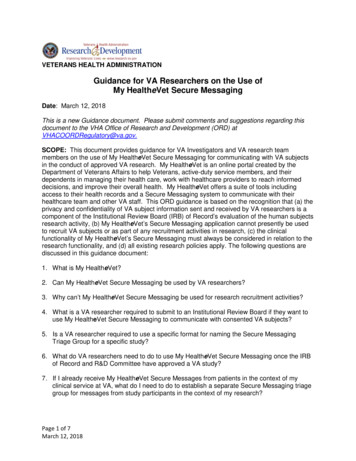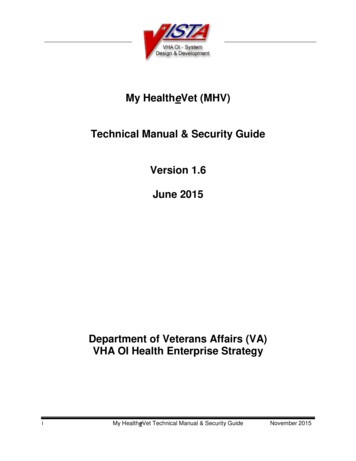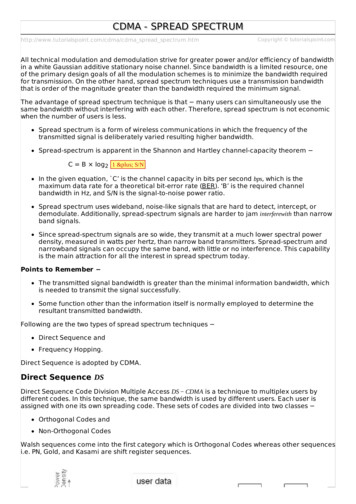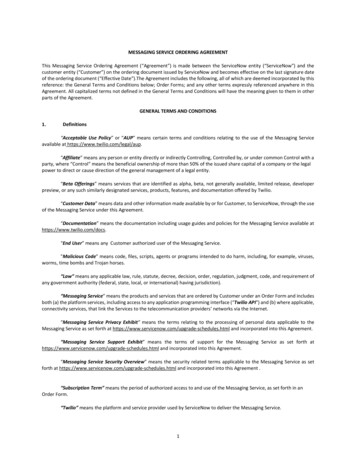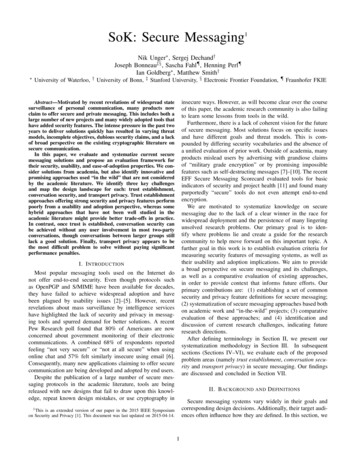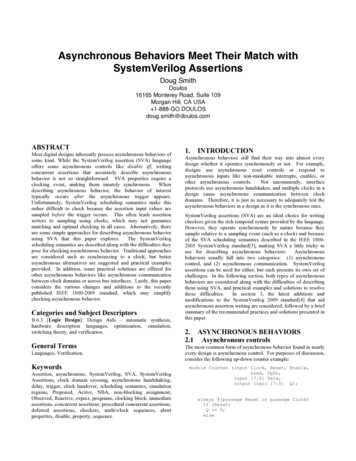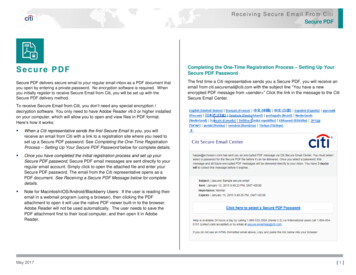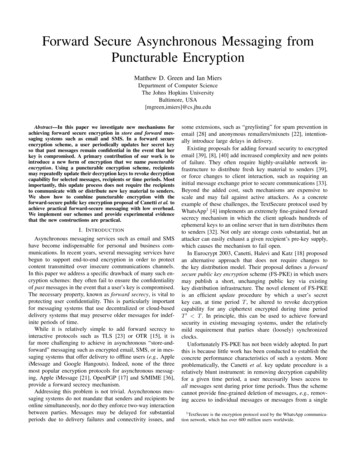
Transcription
Forward Secure Asynchronous Messaging fromPuncturable EncryptionMatthew D. Green and Ian MiersDepartment of Computer ScienceThe Johns Hopkins UniversityBaltimore, USA[mgreen,imiers]@cs.jhu.eduAbstract—In this paper we investigate new mechanisms forachieving forward secure encryption in store and forward messaging systems such as email and SMS. In a forward secureencryption scheme, a user periodically updates her secret keyso that past messages remain confidential in the event that herkey is compromised. A primary contribution of our work is tointroduce a new form of encryption that we name puncturableencryption. Using a puncturable encryption scheme, recipientsmay repeatedly update their decryption keys to revoke decryptioncapability for selected messages, recipients or time periods. Mostimportantly, this update process does not require the recipientsto communicate with or distribute new key material to senders.We show how to combine puncturable encryption with theforward-secure public key encryption proposal of Canetti et al. toachieve practical forward-secure messaging with low overhead.We implement our schemes and provide experimental evidencethat the new constructions are practical.I. I NTRODUCTIONAsynchronous messaging services such as email and SMShave become indispensable for personal and business communications. In recent years, several messaging services havebegun to support end-to-end encryption in order to protectcontent transmitted over insecure communications channels.In this paper we address a specific drawback of many such encryption schemes: they often fail to ensure the confidentialityof past messages in the event that a user’s key is compromised.The necessary property, known as forward secrecy, is vital toprotecting user confidentiality. This is particularly importantfor messaging systems that use decentralized or cloud-baseddelivery systems that may preserve older messages for indefinite periods of time.While it is relatively simple to add forward secrecy tointeractive protocols such as TLS [23] or OTR [15], it isfar more challenging to achieve in asynchronous “store-andforward” messaging such as encrypted email, SMS, or in messaging systems that offer delivery to offline users (e.g., AppleiMessage and Google Hangouts). Indeed, none of the threemost popular encryption protocols for asynchronous messaging, Apple iMessage [21], OpenPGP [17] and S/MIME [36],provide a forward secrecy mechanism.Addressing this problem is not trivial. Asynchronous messaging systems do not mandate that senders and recipients beonline simultaneously, nor do they enforce two-way interactionbetween parties. Messages may be delayed for substantialperiods due to delivery failures and connectivity issues, andsome extensions, such as “greylisting” for spam prevention inemail [28] and anonymous remailers/mixnets [22], intentionally introduce large delays in delivery.Existing proposals for adding forward security to encryptedemail [39], [8], [40] add increased complexity and new pointsof failure. They often require highly-available network infrastructure to distribute fresh key material to senders [39],or force changes to client interaction, such as requiring aninitial message exchange prior to secure communications [33].Beyond the added cost, such mechanisms are expensive toscale and may fail against active attackers. As a concreteexample of these challenges, the TextSecure protocol used byWhatsApp1 [4] implements an extremely fine-grained forwardsecrecy mechanism in which the client uploads hundreds ofephemeral keys to an online server that in turn distributes themto senders [32]. Not only are storage costs substantial, but anattacker can easily exhaust a given recipient’s pre-key supply,which causes the mechanism to fail open.In Eurocrypt 2003, Canetti, Halevi and Katz [18] proposedan alternative approach that does not require changes tothe key distribution model. Their proposal defines a forwardsecure public key encryption scheme (FS-PKE) in which usersmay publish a short, unchanging public key via existingkey distribution infrastructure. The novel element of FS-PKEis an efficient update procedure by which a user’s secretkey can, at time period T , be altered to revoke decryptioncapability for any ciphertext encrypted during time periodT 0 T . In principle, this can be used to achieve forwardsecurity in existing messaging systems, under the relativelymild requirement that parties share (loosely) synchronizedclocks.Unfortunately FS-PKE has not been widely adopted. In partthis is because little work has been conducted to establish theconcrete performance characteristics of such a system. Moreproblematically, the Canetti et al. key update procedure is arelatively blunt instrument: in removing decryption capabilityfor a given time period, a user necessarily loses access toall messages sent during prior time periods. Thus the schemecannot provide fine-grained deletion of messages, e.g., removing access to individual messages or messages from a single1 TextSecure is the encryption protocol used by the WhatsApp communication network, which has over 600 million users worldwide.
sender. The practical consequence is that an implementationthat aims to preserve user experience must by either riskupdating the key before all messages have arrived – or itmust leave some messages exposed until the receiver can becertain that it is safe to wind the key forward. When onefactors in clock drift and delivery latency, the result may be aperiod ranging from hours to weeks during which data remainsvulnerable.Our contributions. In this work we systematically explorethe problem of providing forward secrecy in asynchronousmessaging systems. Our overall goal is to develop public keyencryption that allows for fine-grained revocation of decryption capability only for specific messages, while minimizingcost and storage requirements. As with the Canetti et al.approach, our goal is to use short, unchanging public keys.Unlike previous solutions, we require that the secret key updateprocedure remove access at the level of individual ciphertextsor message senders, while retaining the ability to decrypt allother messages.To achieve this goal, we employ two new ingredients. First,we introduce a a new form of public-key encryption that supports revocation of individual messages. We refer to this newencryption scheme as puncturable encryption. The primitivecan be thought of as a form of tag-based encryption [31] whichadds an efficient Puncture algorithm that, on input the currentsecret key SK and a tag t {0, 1} , outputs a new secret keySK0 that will decrypt all ciphertexts not encrypted under tag t.Secret keys in this scheme can be repeatedly and sequentiallypunctured at many different points, replicating the experienceof normal message deletion.Second, we show how to merge puncturable encryption intoa variant of Canetti et al. FS-PKE, modified to allow finegrained revocation of specific time intervals without revokingall previous intervals. By combining these approaches into aunified scheme, we show how to implement practical forwardsecure public key encryption under reasonable workloads.More specifically, our contributions are as follows:1) We define puncturable encryption, propose security definitions for the primitive, and offer an efficient construction secure under well-studied assumptions in bilineargroups. Our construction is based on a non-monotonicAttribute Based Encryption (ABE) scheme due to Ostrovsky, Sahai and Waters [35], modified to realize a newkey update functionality. After n puncture operations,our construction features O(1) public key, ciphertext sizeand encryption cost, and O(n) secret key storage anddecryption cost.2) To improve efficiency, we show how to compose puncturable encryption with an optimized FS-PKE construction due to Boneh et al. [12] that allows for revocationof individual time periods. This combination realizes the“best of both worlds”, allowing a user to instantly deleteselected messages with precision, while dramaticallyreducing decryption cost over puncturable encryptionalone. The advantage of this approach is that totaldecryption and key storage cost now grow linearly onlyin the maximum number of messages received withina given time period, and only logarithmically in thenumber of time periods.Interestingly, our results show that composing theseschemes is not simply a matter of running both inparallel, but requires that they be carefully combinedsuch that the resulting keys provide collusion resistanceagainst an adversary who seeks to recombine keys fromdifferent time periods.3) Finally, we provide a software implementation ofthe combined scheme both as a standalone librarylibforwardsec and describe how to integrate it withtools such as Gnu Privacy Guard [5]. We then usethe new tools to conduct experiments evaluating theoverhead of deploying puncturable and forward securityencryption under various simulated usage scenarios.Outline of this paper. The rest of this paper is structuredas follows. In the remainder of this section we discuss theintuition behind our constructions. In §II and §III we providebackground and formal definitions for the puncturable encryption primitive and in §IV present our main construction. In §Vwe show how to combine puncturable encryption efficientlywith FS-PKE. In §VI, §VII, §VIII and §IX we describe theimplementation and evaluation of our proposals. In §X wediscuss other applications of these proposals. Finally, in §XIwe discuss related work.A. Encryption ModelWe now briefly explain the framework we use to describeencryption in asynchronous messaging systems. An asynchronous messaging network consists of a set of senders and aset of recipients, all interacting via an insecure channel. For thepurposes of this work we will assume that senders have somemeans to obtain a single authentic public encryption key foreach recipient they wish to communicate with. Instantiationsof this model include the existing OpenPGP infrastructure, aswell as systems like Apple iMessage [17], [21].Conversations can be broken down into two types of message: initial messages between a sender and recipient, andoptional interactive messages. In an asynchronous system,each conversation consists of at least one initial message,optionally followed by an interactive exchange between thecommunicating parties. In this work we are primarily concerned with the forward secrecy of initial messages, since theforward secrecy of subsequent interactions may be achievedby using an interactive “ratcheting” protocol such as OTR [15]or TextSecure/Axolotl [32].The approach we propose in this work is to attach to eachinitial message a unique identifier, or “tag”, generated by theencrypting party. Upon receiving this message, the receivingparty may – at its discretion – revoke decryption capabilityfor the received message via a secret key update. Since our
puncturable encryption constructions support tags in the space{0, 1} , the sender can use any unique string for the messageidentifier. Example tags might include a GUID (which weuse in our experiments), or alternatively a concatenation ofsender ID and a monotonically-increasing message counter.On receipt of a message, the recipient can securely revokedecryption capability for only that message by “puncturing”the secret key on that tag. Our puncturable constructionsalso support employing multiple tags per message. In thiscase, the unique message ID may be supplemented withadditional meta-data such as the sender ID. This approachallows receivers to revoke entire classes of message (e.g., allmessages from a given sender).There are two limitations of our approach: (1) the cost ofdecrypting a message with a given key increases linearly in thenumber of punctures in that key and (2) an active attacker mayblock messages from reaching the recipient, thus preventingthe recipient from revoking access to these messages. Toaddress these concerns, in Section V we propose to combinedpuncturable encryption with forward secure encryption. In thisapproach, the sender simultaneously encrypts each messagewith both a time period and a unique message identifier. Thereceiver may instantly perform both fine-grained revocation ofthe messages it receives, but also possesses a coarse-grainedupdate mechanism to revoke messages older than a certaintime period in the past. We refer to the time period for whichthe recipient can decrypt as the “decryption window”. Thisdual approach is roughly analogous to the fine- and coarsegrained revocation approach used in TextSecure [32], but doesnot require distribution of pre-keys to the sender. Crucially forefficiency, decryption time for a message arriving in intervalT is linearly only in the punctures done for interval T, not thetotal number of punctures.In Section IX we discuss choices for parameters such asmessage ID format, time period interval length, and the sizeof decryption windows.B. Intuition: Puncturable EncryptionTo explain the intuition behind our constructions, let us firstaddress some trivial solutions. We consider schemes in whichan encryptor attaches a “tag” such as a message identifier(or time period identifier) to each message sent to a givenreceiver. The goal of the system is to allow the receiverto selectively revoke the ability to decrypt specific tags. Insystems with only a polynomially number of time periods(or “tags”) T , it is simple to realize (inefficient) puncturableencryption by generating a unique PKE keypair correspondingto each “tag” a sender might encrypt under. Puncturing thekey is simply a matter of deleting the corresponding secret.One can improve upon the O( T ) public key size of thisconstruction using identity-based encryption to produce O(1)sized public parameters for use as the public key, deriving IBEdecryption keys for all tags t T , and destroying the mastersecret.Unfortunately these simple approaches have secret key storage that is linear in the total number of allowable tags, not thecurrent number of punctured tags. Not only is this inefficient, itlimits the maximum number of possible tags (or time periods)to be at most polynomial in the security parameter. This clearlyrules out exponentially-sized tag spaces, for example, stringssuch as sender addresses or unique message identifiers. Asmaller tag space raises the possibility of tag collisions, wheremultiple messages from different senders are given the sametag, and thus the second message cannot be decrypted.To address these issues, we take a different approach. Ratherthan deleting elements from an existing decryption key, wedesire a structure that allows us to add new restrictions on whatthe key can decrypt. The logical building block for our construction is a form of attribute-based encryption scheme thatsupports non-monotonic access formulas. In such schemes,decryption keys may comprise boolean formula containingboth positive and negated attributes, e.g., “NOT t”.In and of itself non-monotic ABE is not sufficient toconstruct puncturable encryption, since we must also supportthe ability to add negations to an existing decryption key. Acritical observation here is that by formulating a key containingonly negations, some constructions can be modified to supportthe creation of new negations within an existing key.Our concrete proposal begins with an NM-ABE construction due to Ostrovsky, Sahai and Waters [35], which weconfigure as a form of tag-based encryption supporting a fixednumber d of tags per ciphertext. To generate a key pair, auser first produces parameters for an instance of the ABEscheme, publishes the public parameters as her public key PK,derives a decryption key from the master secret key MSK, anddestroys the master secret MSK.At all times subsequent to initial key generation, the recipient’s secret key is an ABE decryption key embedding a policyconsisting of only negated attributes. To puncture a key at anadditional point t, the recipient updates her existing secret keyto derive a new key that also embeds the negation of t. Thisis possible in the Ostrovsky et al. scheme due to the structureof these negated key components. Specifically, within eachnegated key component, Ostrovsky et al. embed one secretshare λ of the master secret α. Due to the nature of thisscheme, it is possible to re-share the value λ from any givenkey component, by generating λ0 and mauling the original keycomponent to embed the share λ λ0 . Simultaneously, onemay create a new negated key component embedding shareλ0 , and bound to the newly punctured tag t. This providesour puncture algorithm, which can be operated an arbitrarynumber of times.Combining Puncturable Encryption with FS-PKE. As mentioned above, to ensure forward secrecy under active attackand allow for more efficient decryption, we need to combinePuncturable Encryption with FS-PKE.The naı̈ve approach to combining the two schemes is simplyto operate FS-PKE in parallel with puncturable encryption,
encrypting every plaintext across both systems.2 However thisapproach is problematic. There is no obvious mechanismfor reducing the complexity of a punctured secret key afterwinding the FS-PKE key forward – i.e., for removing NOTgates. To solve this problem, during time period T we mightinstead retain a copy of the initial unpunctured secret key foruse in time period T 1. Unfortunately this poses a newchallenge: if an attacker compromises the recipient’s computer,she will be able to combine this unpunctured secret key withthe FS-PKE secret key for time period T , and thus accessmessages that should be inaccessible.Our solution to this problem is to cryptographically bindthe secret keys for the FS-PKE scheme with those for thepunctured encryption scheme. Thus an attacker who obtainsthe secrets for time period T and T 1 cannot recombineany portions of the key to obtain access to messages deletedduring the earlier time period. In §V we show how to achievethis combination using an efficient FS-PKE derived froma Hierarchical Identity-Based Encryption scheme of Boneh,Boyen and Goh [12]. Given a maximum number of puncturedtags n, and a maximum number L of time periods, thecombined scheme gives O(1) sized ciphertexts and public key,and O(log(L) n) secret key storage and decryption cost.More importantly, we implement this scheme and show thatits actual costs are quite practical.II. BACKGROUNDNotation. Throughout this paper we will use the followingnotation. Let negl (·) represent a negligible function. Let Mrepresent the set of valid plaintexts for a scheme, and let Trepresent the set of valid tags.A. Bilinear MapsLet G and GT be two multiplicative cyclic groups of primeorder p. Let g be a generator of G and e : G G GT bea bilinear map with the properties:1) Bilinearity: for all u, v G and a, b Zp , we havee(ua , v b ) e(u, v)ab .2) Non-degeneracy: e(g, g) 6 1.We say that G is a bilinear group if the group operation inG and the bilinear map e : G G GT are both efficientlycomputable. In practice, we may also define bilinear groupsin the asymmetric setting, where a bilinear map is defined ase : G1 G2 GT for G1 6 G2 and there is no efficientisomorphism γ : G1 G2 . We will describe our schemes inthe symmetric setting, and in §VI will discuss the process oftranslating to the asymmetric setting.The schemes we present in this work are provably secure under the Decisional Bilinear Diffie-Hellman Inversion(DBDHI) (see e.g., [12]) and the Decisional Bilinear DiffieHellman assumption (DBDH) [11] in bilinear groups. Forreasons of space we will omit a definition of these assumptionshere, and refer the reader to the cited works.2 This encryption would be combined: example, a user might split a messageM using a 2-of-2 secret sharing and encrypt each share under one of the twoschemes.III. D EFINITIONSIn this section we provide the syntax and security definitionsfor puncturable encryption.A. Puncturable EncryptionA puncturable encryption scheme is a tuple of probabilisticalgorithms (PPKE.KeyGen, PPKE.Encrypt, PPKE.Decrypt,PPKE.Puncture) with the following syntax:PPKE.KeyGen(1k , d) (PK, SK0 ). On input a securityparameter k, and a maximum number of tags per ciphertext d, output a public key PK and an initial secret keySK0 .PPKE.Encrypt(PK, M, t1 , . . . , td ) CT. On input apublic key PK, a plaintext M and a list of tags t1 , . . . , td ,output the ciphertext CT.PPKE.Puncture(PK, SKi 1 , t) SKi . On input asecret key SKi 1 and a tag t, output a new secret key SKithat can decrypt any ciphertext SK0 can decrypt, exceptfor ciphertexts encrypted with t.PPKE.Decrypt(PK, SKi , CT, t1 , . . . , td ) {M } { }.On input a secret key SKi and a ciphertext CT, output aplaintext M , or if decryption fails.We now define correctness and security for puncturable encryption.B. CorrectnessCorrectness is defined by the following experiment. Oninput (k, M, n, d, t1 , . . . , tn , t 1 , . . . , t d ):1) Compute (PK, SK0 ) PPKE.KeyGen(1k , d)2) If n 0 then for i 1, . . . , n compute SKi PPKE.Puncture(SKi 1 , ti ).3) Set CT PPKE.Encrypt(PK, M, t 1 , . . . , t d ).The scheme is correct if for all sufficiently large k; d 0, n 0 both polynomial in k; t1 , . . . , tn T , t 1 , . . . , t d T \{t1 , . . . , tn }, M M it holds thatPPKE.Decrypt(SKn , CT, t 1 , . . . , t d ) Mwith probability 1 negl (k) taken over the random coins ofthe experiment.Remark. We allow for a negligible correctness error due tothe fact that in our constructions, it is desirable for size of thesecret key to be independent of the length of the tag strings.In practice this implies some negligible probability that twodifferent tags will collide.C. SecuritySecurity for puncturable encryption is defined by the INDPUN-ATK game, which we present in Figure 1. This gameincorporates both CPA and CCA variants. Intuitively, this issimilar to the indistinguishability definition for public keyencryption but adds the following new oracles.On input any tag t T , the Puncture oracle updatesthe secret key to revoke tag t. The adversary may query this
Setup. On input a security parameter k and a maximum number of tags d, the challenger initializes two empty sets P, C and a countern 0. It runs (PK, SK0 ) PPKE.KeyGen(1k , d) and gives PK to the adversary.Phase 1. Proceeding adaptively, the adversary can repeatedly issue any of the following queries: Puncture(t): The challenger increments n, computes SKn PPKE.Puncture(SKn 1 , t) and adds t to the set P . Corrupt(): The first time the adversary issues this query, the challenger returns the most recent secret key SKn to the adversary andsets C P . All subsequent queries return . Decrypt(CT, t1 , . . . , td ): If ATK CPA the challenger returns . If ATK CCA the challenger computes M PPKE.Decrypt(SKn , CT, t1 , . . . , td ) and returns M to the adversary.Challenge. The adversary submits two messages m0 , m1 M along with tags t 1 , . . . , t d T . If the adversary has previously issued aCorrupt query and {t 1 , . . . , t d } C , the challenger rejects the challenge. Otherwise the challenger samples a random bit b, andreturns CT PPKE.Encrypt(PK, Mb , t 1 , . . . , t d ) to the adversary.Phase 2. This phase is identical to Phase 1 with the following restrictions: Corrupt() returns if {t1 , . . . , td } P . Decrypt(CT, t1 , . . . , td ) returns if (CT, t1 , . . . , td ) (CT , t1 , . . . , td ).Guess. The adversary outputs a guess b0 . The adversary wins if b b0 .Fig. 1. IND-PUN-ATK security game for puncturable encryption, with ATK {CPA, CCA}.oracle repeatedly throughout the game, each time producing anew secret key. The Corrupt oracle provides the adversarywith the most recent state of the secret key held by thechallenger. The adversary may challenge on a pair of messagesand chosen tags t 1 , . . . , t d , subject to the restriction thatthe adversary cannot corrupt the secret key unless she haspreviously punctured at least one of the tags t 1 , . . . , t d . Thisrestriction prevents attacks in which the adversary may triviallydecrypt the challenge ciphertext.The CCA variant of the game also adds a decryption oracle. The adversary may call this oracle at anypoint on input (CT, t1 , . . . , td ) with the sole restriction that(CT, t1 , . . . , td ) 6 (CT , t 1 , . . . , t d ), i.e., that she does notquery on the challenge ciphertext and tags. More formally:Definition 3.1 (Security for puncturable encryption): Apuncturable encryption scheme is IND-PUN-ATK secure forATK {CPA, CCA} if for all p.p.t. adversaries A and forsufficiently large k, it holds that A’s advantage in the INDPUN-ATK game is bounded by 1/2 negl (k).IV. C ONSTRUCTIONSWe now present constructions that achieve, respectively,CPA-secure and CCA-secure puncturable encryption underreasonable assumptions in bilinear groups.A. A CPA-secure constructionFigure 2 presents a CPA-secure construction of PuncturableEncryption based on an Attribute-Based Encryption schemeof Ostrovsky, Sahai and Waters (OSW) [35]. As discussedearlier, the basic construction is an adaptation of the OSWscheme, with the addition of a Puncture algorithm that, oninput a secret key SK and tag t outputs SK0 with an additionalcomponent for the negation of tag t. Our key observationis that individual secret key components can be “re-shared”using only public parameters. This process is described in thePuncture algorithm.For space reasons we omit a proof of correctness and movedirectly to our main security theorem for the security of theCPA construction.Theorem 4.1: The puncturable encryption scheme of Figure 2 is IND-PUN-CPA secure in the random oracle modelif the Decisional Bilinear Diffie-Hellman (DBDH) assumptionholds in G, GT .The proof of Theorem 4.1 draws extensively from the proofof [35], adding mainly the additional details of simulating thePuncture algorithm. We sketch this proof in the full versionof this paper.of the full v.B. CCA securityThe puncturable encryption scheme presented in Figure 2provides only CPA security. We now describe how to modifythis scheme to achieve CCA security. Our approach uses theFujasaki-Okamoto transform [24] which is commonly used toefficiently transform a CPA-Secure scheme into a CCA-secureone.Let M0 {0, 1} be a plaintext space and letH1 : GT M0 T d Zp and H2 : GT {0, 1} be two independent hash functions. Given theCPA-secure puncturable encryption scheme (PPKE.KeyGen,PPKE.Encrypt, PPKE.Decrypt, PPKE.Puncture) from Figure 2 where PPKE.Encrypt uses random element s Zp , wedefine a modified scheme (PPKE.KeyGen, PPKE.Encrypt0 ,PPKE.Decrypt0 , PPKE.Puncture) where PPKE.Encrypt0 andPPKE.Decrypt0 are defined as follows:PPKE.Encrypt0 (PK, M, t1 , . . . , td ). First select a randomelement Σ GT , compute s H1 (Σ, M, (t1 , . . . , td ))and compute CT0 PPKE.Encrypt(PK, Σ, t1 , . . . , td )using s as the encryption randomness. Now output CT (CT0 , H2 (Σ) M ).PPKE.Decrypt(SKi , CT, t1 , . . . , td ).parse CT as (CT0 , S) and computeΣ0First
PPKE.Keygen(1k , d). On input a security parameter k and number of tags associated with a ciphertext d, choose a group G of primeorder p, a generator g and a hash function H : {0, 1} Zp . Chooses random exponents α, β Zp and set g1 g α , g2 g β .Finally sample r Zp and a degree-d polynomial q(·) subject to the constraint that q(0) β. Define V (x) g q(x) . Letting t0 be adistinguished tag not used during normal operation, output:PK g, g1 , g2 , g q(1) , . . . , g q(d)(1)SK0 [(sk0(2) g2α r , sk0(3) V (H(t0 ))r , sk0 g r , sk(4) t0 )]The parameters g2 , g q(1) , . . . , g q(d) allow any party to compute V (·) by interpolating in the exponent.PPKE.Encrypt(PK, M, t1 , . . . , td ) On input the public parameters PK, a message M to encrypt and a set of tags t1 , . . . , td {0, 1} \{t0 }.Sample a random s from Zp and output CT ct(1) M · e(g1 , g2 )s , ct(2) g s , ct(3,1) V (H(t1 ))s , . . . , ct(3,d) V (H(td ))salong with the tags (t1 , . . . , td ).PPKE.Puncture(PK, SKi 1 , t) On input an existing secret key SKi 1 and a tag t {0, 1} \ {t0 }. First parse SKi 1 as(1)(2)(3)[sk0 , sk1 , . . . , ski 1 ] and further parses sk0 as (sk0 , sk0 , sk0 , t0 ). Next sample λ0 and r0 , r1 at random from Zp and compute: 0(3)(2)(1)sk00 sk0 · g2r0 λ , sk0 · V (H(t0 ))r0 , sk0 · g r0 , t0 0ski g2λ r1 , V (H(t))r1 , g r1 , tIt outputs the new key SKi [sk00 , sk1 , . . . , ski 1 , ski ].PPKE.Decrypt(SKi , CT, t1 , . . . , td ) On input a private key SKi , a ciphertext CT and a set of tags t1 , . . . , td associated with the ciphertext.Parse the ciphertext CT as (ct(1) , ct(2) , ct(3,1) , . . . , ct(3,d) ) and parse SKi as [sk0 , sk1 , . . . , ski ].(4)(4)(3)(2)(1)For j 0, . . . , i parse ski as (ski , ski , ski , ski ). Next compute a set of coefficients ω1 , . . . , ωd , ω such that (ω ·q(H(ski ))) Pd(ω·q(H(t))) q(0) β.Finallycomputekkk 1(1)Zj and output M ct(1) /Qij 0e(skj , ct(2) ) Q(3)(2)e skj , dk 1 (ct(3,k) )ωj · e(skj , ct(2) )ω Zj .Fig. 2. A CPA-secure puncturable PKE scheme based on the ABE construction of Ostrovsky, Sahai, and Waters [35].PPKE.Decrypt(SKi , CT0 , t1 , . . . , td ).Nextcompute M 0 S H2 (Σ) and computes0 H1 (Σ, M 0 , (t1 , . . . , td )). Finally, using0sas the randomness, compute CT00 PPKE.Encrypt(PK, Σ0 , t1 , . . . , td ) and if CT0 6 CT00return . Otherwise return M 0 .tags. This can become unwieldy after a large number ofpunctures.V. P UNCTURABLE FORWARD SECURE PKEIn this section we show how to mitigate this issue by combining puncturable encryption with a forward-secure publickey encryption scheme [18] based on an efficient HierarchicalIdentity Based Encryption (HIBE) Scheme. In the modifiedconstruction, senders encrypt under a time period T and alist of tags (t1 , . . . , td ). Receivers may puncture their keyswithin the current time period (or most recent n time periods),eventually usi
Puncturable Encryption Matthew D. Green and Ian Miers Department of Computer Science The Johns Hopkins University Baltimore, USA [mgreen,imiers]@cs.jhu.edu Abstract—In this paper we investigate new mechanisms for achieving forward secure encryption in store and forward mes-saging systems such as email and SMS. In a forward secure
